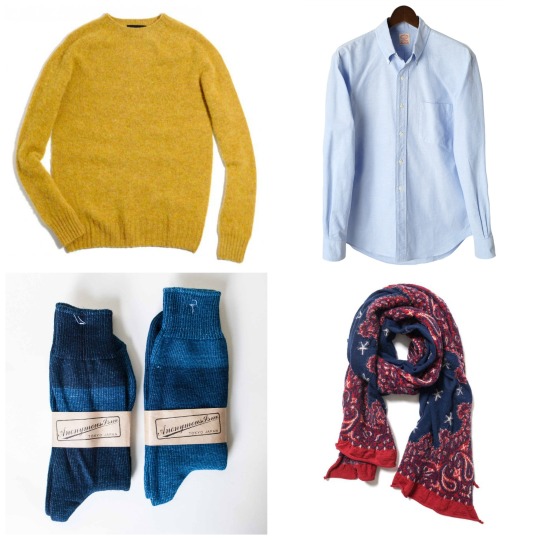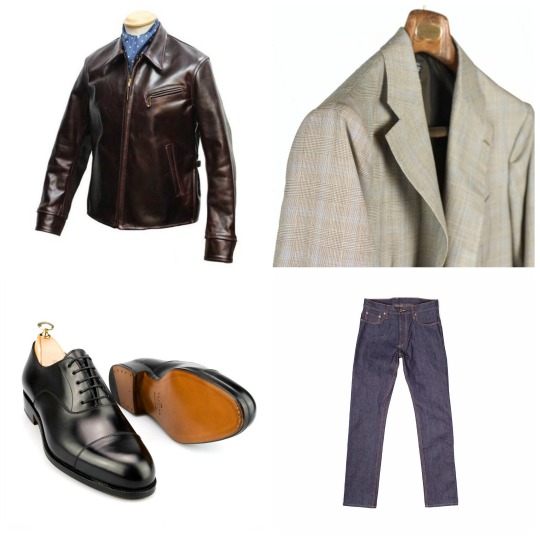Browsing a site like Mr. Porter, with multiple, clear photos of nearly every item (on a model! with other clothes!), measurements, etc., it’s easy to forget that a decade ago e-commerce was still pretty clunky–infrequently updated stock, bad interfaces, bad photos, and limited product info. You no longer have to live in or visit New York, Los Angeles, London, Paris, or Tokyo to see the coolest and finest men’s clothing or even great vintage.
But shopping in person is irreplaceable–you get the expertise of the staff (where you can find it), the serendipity of stumbling on something awesome you may not have been looking for, and most importantly, the ability to try something on and make sure it fits your body and style.
Living outside of the style meccas of the world, I’ve bought more than my share of gear online, and I’ve made many mistakes. Mistakes you can learn from, even if I have not. Some types of items I have a fantastic hit rate. I find cool stuff that I wear all the time, and often at a good price (that I may not have known was out there were I in a physical shop). For others, I have the Goodwill donation receipts to prove my high rate of failure.

The Best Things to Buy Online
Accessories: The number one reason stuff you order online doesn’t work out is that it just doesn’t fit you, so things that are broadly sized or not at all sized are lower risk to shop for on-screen. Socks. Jewelry. Scarves. Ties. Bags. If the shop has decent photos, you won’t often be returning these sorts of items. Hats, gloves, and sunglasses can be trickier–hats and gloves need to fit right and numbered sizes don’t always tell the whole story, and it’s nearly impossible to tell if sunglasses will work with your face and head shape without trying them on (although we have some tips).
Sneakers: Although sneakers clearly don’t all fit the same (a size 10 is not a size 10 is not a size 10), within a single brand the fit usually has some consistency, and absolutely NAILING the fit is less vital to whether you’ll wear sneakers than it is for other things. I.e., sneakers are a little forgiving–if you have a good idea of your Brannock size you can pretty safely order some kicks. An added advantage is that sneakers from big brands are sold so broadly that it’s often easy to find sales or other discounts on major brand models.
Knits: Just by virtue of having a little give, knits tend to be an easier item to get right, or at least right enough.
Woven shirts: Measuring a shirt you own for which you like the fit is key when shopping for button front shirts online. They tell you a lot about the fit of the shirt. Many stores, like Mr. Porter and No Man Walks Alone, list measurements for most of their items, and for shirts I find such measurements particularly illustrative (they can be less helpful for items that are more three dimensional in spirit, like suits). It’s also important to check whether a shirt has darts in the back, as that is usually a sign it will have a slimmer fit, even if the seller doesn’t provide a waist measurement.
T-shirts: Like woven shirts, I largely think of t-shirts as two dimensional; it’s pretty easy to tell from a chest and shoulder measurement if a shirt is going to fit. When buying vintage shirts, definitely insist on such measurements when you can, as shrinkage over time and broad changes in style mean a size large from the 1970s and one from today will fit very differently, even if a numerical size is also given (e.g., L/42-44).

Things Better to Shop for In-Person
Dress shoes: I’m fortunate in that I don’t have particularly hard-to-fit feet, but one of the things that bothers me the most is when I get a pair of dress shoes that isn’t quite right. First of all, different lasts and styles, even from the same maker, can fit quite differently. A closed lace shoe (like the Carmina bals pictured above) is less forgiving than an open laced shoe, for example. And it’s a challenge to try on ordered shoes to get an adequate feel for their fit without creasing them or marking the soles, which is like driving the car off the lot–the resale value plummets. An experienced shoe salesperson can help a lot with telling you what will and won’t fit and look right on your feet.
Tailoring: Well-made suits and sportcoats are absolutely complex, three-dimensional objects, built with volume, seams, and darts intended to fit and move with you, and that, altogether, add up to a style–could be businesslike and square, sharp and modern, or soft and casual. Dimensions observable online, such as chest, shoulder, or sleeve measurements, can tell you whether a garment will actually fit over your body, but have a hard time communicating the true fit or vibe of a piece of tailoring.
Now, I’ve bought a lot of tailoring online, new and vintage; and it helps that, after purchase, a tailor can make alterations, sometimes significant ones, to fit you better. But it’s much more satisfying, in my opinion, to be able to try on a couple of different sizes and find out which one is really right for you. It may not be the size you always wear.
Leather jackets: Likewise the fit and vibe of a leather jacket can be hard to discern from photos and measurements on a screen. Most leathers are designed to be worn close to the body, so sometimes the measurements will appear relatively slim even though the jacket will in fact fit. (E.g., a shirt you wear under the jacket will likely measure larger through the chest than the jacket.)
And like many of these items, vintage is a special challenge because styles have changed so much over time–a double rider jacket today may not fit like one from the same maker from the 1980s. And the market is littered with leathers from the 1990s that have low armholes and broad shoulders–a look to be sure, but not likely what you’re shopping for in 2018.
Jeans: It’s disappointing that jeans are a challenge to shop for online, because there are not a lot of stores offering really great, interesting denim. So outside of big cities, online is your only option. But again, fit is the factor that’s so hard to get right from the impressions you can get online. And the waist, seat, and thighs on a pair of jeans can be harder to alter successfully than on a pair of dress trousers, which are designed with alteration in mind.
Ways to Make Buying Online Work Better
- Talk with a sales associate in advance: if you’re a natural introvert like me, part of the appeal of online shopping is not actually dealing with people. But when you’re not sure of the cut or feel of a piece of clothing, talking to someone who might be able to look at and handle it for you can be very helpful. If you can’t make it in to the store, give ‘em a call (or email, or tweet, or DM).
- Order multiple sizes: I don’t particularly like running up charges I don’t absolutely need to, but in cases where I’m not sure of the size I’ll prefer, I’ll often order two or even three sizes in one item to see which fits best. Obviously there’s a cost here, as many stores don’t cover return shipping and some don’t have free returns, but if shipping is <$20 and the item is hundreds of dollars, it’s worth a little extra to make sure I made the right choice. See also tip #1, because some stores will waive return fees and even shipping if they know you’re ordering to compare sizes–can’t hurt to ask. (Apologies in advance to all stores everywhere.)
- Support good stores: One of the benefits of shopping online is being able to compare prices very quickly and pick the best one. But the lowest price may not be the best long term value. Maybe you found the item initially at a local shop, or one that had a great lookbook that showed it in a context that appealed to you, or one that went through the trouble of measuring the item and/or communicating with you directly about it while you were making your decision. Reward those stores with your business, even if they don’t have the absolute lowest price.








